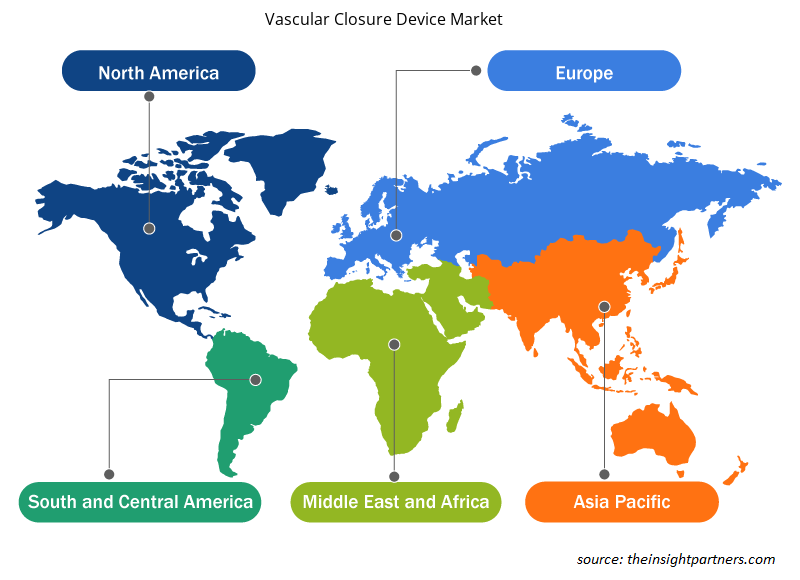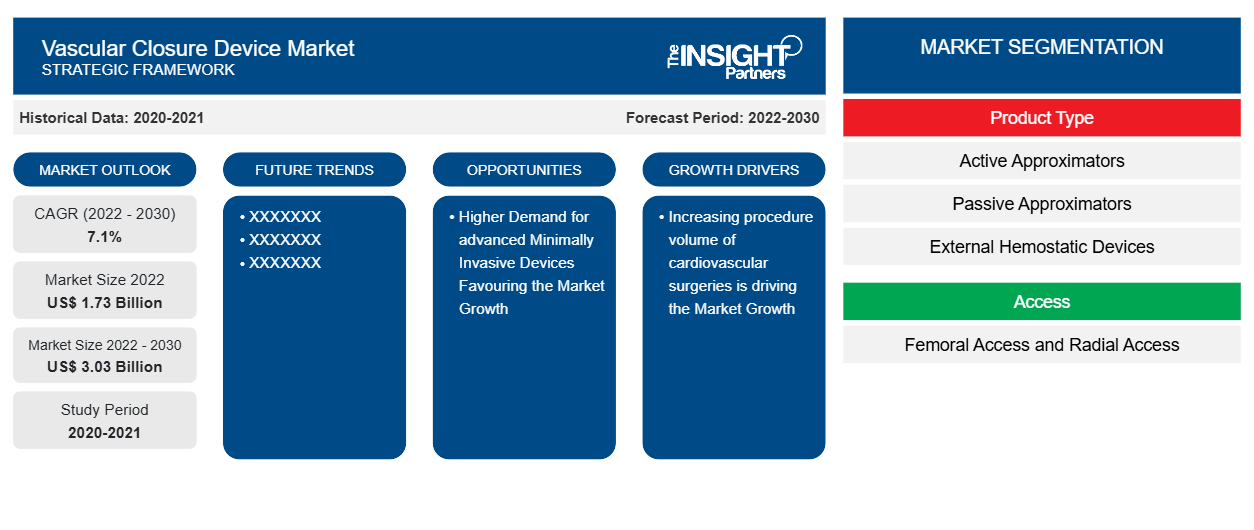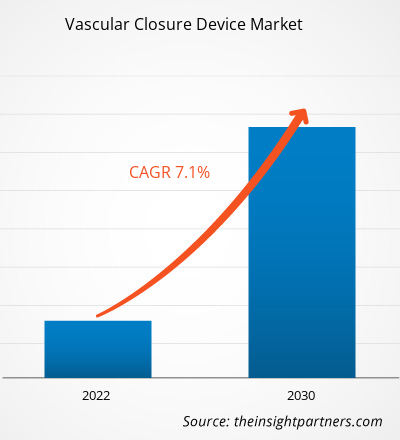血管闭合装置市场规模预计将从 2022 年的 17.3 亿美元增至 2030 年的 30.3 亿美元。预计 2022-2030 年市场复合年增长率为 7.1%。全球市场的增长主要归因于心血管疾病发病率的提高和对微创设备的需求不断增长。然而,与血管闭合装置相关的感染风险可能会阻碍市场的增长。
血管闭合装置市场分析
血管闭合装置 (VCD) 是血管内手术或其他心血管手术后使用的医疗设备,这些手术需要导管插入来实现动脉小孔的止血。导管插入是各种心血管手术所必需的,包括冠状动脉血栓切除术、血管成形术和支架插入等介入手术,这些手术有助于诊断受损的动脉。心血管疾病是全球死亡的主要原因之一,包括急性心肌梗塞、心绞痛和动脉粥样硬化。因此,血管闭合装置的市场扩张是由对微创设备的需求增加推动的。
血管闭合装置市场概况
动脉粥样硬化、心绞痛、急性心肌梗死等心血管疾病是全球死亡的主要原因。根据世界卫生组织(WHO)提供的数据,心血管疾病每年导致近1790万人死亡,是所有非传染性疾病中死亡的主要原因,其次是癌症、慢性呼吸系统疾病和糖尿病(包括与肾脏疾病相关的死亡)。根据世界心脏联盟的数据,高胆固醇每年导致440万人死亡,约24%的心血管相关死亡与高低密度脂蛋白(LDL)水平有关。根据NCBI 2023年1月发布的一项研究,在美国,50岁及以上人口的数量很可能从2020年的1.3725亿增至2050年的2.2113亿。在这个年龄段的人群中,患有至少一种慢性病的人数预计将增加99.5%,从2020年的7152万人增至2050年的1.4266亿。此外,到2050年,约有1400万50岁及以上的人可能患有合并症。
血管闭合装置 (VCD) 为在经股动脉通路进行侵入性心血管治疗后提高患者的舒适度和活动能力提供了一种新方法。血管闭合装置用于不同的治疗方法,以提供简单、快速和可靠的止血。在美国,股动脉通路是经皮冠状动脉介入治疗 (PCI) 和冠状动脉造影最常用的血管通路技术。尽管如此,近年来,经桡动脉通路进行心导管插入术和经皮冠状动脉介入治疗 (PCI) 的关注度有所增加。已经开发了几种股动脉闭合装置来缩短血管闭合时间,临床试验中观察到不同程度的血管并发症。血管闭合装置 (VCD) 已成为心导管插入术后传统机械压迫程序的有效替代方案。VCD 缩短了住院时间,加快了患者活动速度,并缩短了止血所需的时间。因此,随着心血管疾病患病率的不断上升,血管闭合装置市场也显著增长。
定制此报告以满足您的需求
您可以免费定制任何报告,包括本报告的部分内容、国家级分析、Excel 数据包,以及为初创企业和大学提供优惠和折扣
- 获取此报告的关键市场趋势。这个免费样品将包括数据分析,从市场趋势到估计和预测。
血管闭合装置市场驱动因素和机遇
微创设备需求增加利好市场
医学科学和技术的进步已让位于微创设备,这些设备可以帮助用微创或非侵入性方法取代传统的痛苦手术方法。微创技术在心脏手术等外科领域越来越受欢迎。许多此类手术都是通过股动脉插管进行体外循环的。血管闭合装置越来越受欢迎,因为它们减少了侵入性并取代了手术切开以插入股动脉。血管闭合装置主要用于经导管和血管内干预,以促进伤口愈合并缩短手术时间。
血管造影术是血管外科、介入放射学以及诊断和介入心脏病学等各种专业中执行的常见程序之一。血管闭合装置在大型体型以及抗凝和抗血小板治疗中很有用。它们还用于可能不适合长期卧床休息的情况(例如患有广泛压疮的患者)。一种具有可吸收胶原材料的血管闭合装置已被引入用于经股动脉经导管主动脉瓣植入术 (TAVI),该装置无需使用缝合材料。例如,Teleflex Medical Inc. 的 MANTA 装置足以闭合高达 25 Fr 的动脉通路部位。该系统的安全性和有效性在现实世界的 TAVI 患者群中得到了证明。因此,对微创设备的需求不断增长推动了血管闭合装置市场的增长
新兴经济体尚未开发的潜力——血管闭合装置市场的机遇
血管闭合装置市场参与者应预计印度、中国、阿根廷、巴西、阿联酋和南非等新兴国家将迎来巨大的增长机会,原因是可支配收入不断增长、患者人口老龄化、研发增加、医疗基础设施改善、心血管疾病意识不断提高以及与发达国家相比指导方针相对宽松。根据世界经济论坛的数据,截至 2022 年,俄罗斯、巴西、中国、印度和南非合计占全球医疗支出的三分之一。世界银行报告称,2018 年至 2019 年,印度的医疗支出增长了 3.01%,中国增长了 5.35%。此外,过去十年来,新兴市场的心力衰竭病例激增,导致大量心血管疾病相关死亡。根据印度品牌资产基金会的数据,医院为印度医疗保健行业的收入贡献了约 70%。在中国,私立医院的数量在 2022 年将达到 36,000 家。此外,私立医院占该国医院总数的约 57%。由于医疗支出增加和目标患者人数激增,发展中市场的外科中心和医院数量估计将增加。因此,发展中经济体医疗设施的发展以及医院数量的激增将推动新兴经济体对血管闭合装置的认识和采用。此外,发达或成熟市场的激烈竞争鼓励血管闭合装置制造商专注于发展中市场,这可能会为血管闭合装置供应商提供增长机会,使其在市场上占据重要地位。
血管闭合装置市场报告细分分析
有助于得出血管闭合装置市场分析的关键部分是产品类型、途径、程序和最终用户。
- 根据产品类型,血管闭合装置市场分为主动闭合器、被动闭合器和外部止血器。被动闭合器设备部分在 2022 年占据了更高的市场份额。
- 根据通路,市场分为股动脉通路和桡动脉通路。
- 按照程序而言,市场分为介入心脏病学、介入放射学和血管内外科。
- 就最终用户而言,市场分为医院、ABSc 和其他。
血管闭合装置市场份额按地区分析
血管闭合装置市场报告的地理范围主要分为五个区域:北美、亚太、欧洲、中东和非洲、南美/南美和中美。
在北美,血管闭合装置市场在预测年份内目前正在经历指数级增长。北美血管闭合装置市场分为美国、加拿大和墨西哥;美国在 2022 年占据了最大的市场份额。美国是医疗创新和医疗保健技术进步的中心。微创手术相关技术的不断进步、闭合装置技术的改进以及新型闭合装置的推出促进了美国血管闭合装置市场的增长。例如,2023 年 3 月,Haemonetics Corporation (US) 向 Vivasure Medical Limited 投资了约 3172 万美元(3000 万欧元)。2023 年 3 月,Vivasure Medical 宣布获得 FDA IDE 批准,启动一项美国关键研究,评估 Vivasure PerQseal 闭合装置系统的安全性和有效性。 2021 年,VASCADE MVP 成为第一个也是唯一一个获得 FDA 批准的适用于心房颤动 (AF) 消融后使用并可当天出院的血管闭合装置。
血管闭合装置市场区域洞察
Insight Partners 的分析师已详尽解释了预测期内影响血管闭合装置市场的区域趋势和因素。本节还讨论了血管闭合装置市场的各个部分和地理位置,包括北美、欧洲、亚太地区、中东和非洲以及南美和中美洲。

- 获取血管闭合装置市场的区域特定数据
血管闭合装置市场报告范围
| 报告属性 | 细节 |
|---|---|
| 2022 年市场规模 | 17.3亿美元 |
| 2030 年市场规模 | 30.3亿美元 |
| 全球复合年增长率(2022 - 2030 年) | 7.1% |
| 史料 | 2020-2021 |
| 预测期 | 2022-2030 |
| 涵盖的领域 | 按产品类型
|
| 覆盖地区和国家 | 北美
|
| 市场领导者和主要公司简介 |
|
血管闭合装置市场参与者密度:了解其对业务动态的影响
血管闭合装置市场正在快速增长,这得益于终端用户需求的不断增长,而这些需求又源于消费者偏好的不断变化、技术进步以及对产品优势的认识不断提高等因素。随着需求的增加,企业正在扩大其产品范围,进行创新以满足消费者的需求,并利用新兴趋势,从而进一步推动市场增长。
市场参与者密度是指在特定市场或行业内运营的企业或公司的分布情况。它表明在给定市场空间中,相对于其规模或总市场价值,有多少竞争对手(市场参与者)存在。
在血管闭合装置市场运营的主要公司有:
- Cordis 公司
- 透光技术有限公司
- 瓦索鲁姆有限公司
- Haemonetics 公司
- 雅培实验室
- 碧迪公司
免责声明:上面列出的公司没有按照任何特定顺序排列。

- 了解血管闭合装置市场的主要参与者概况
血管闭合装置市场新闻和最新发展
血管闭合装置市场通过收集主要和次要研究后的定性和定量数据进行评估,其中包括重要的公司出版物、协会数据和数据库。以下是市场创新、业务扩展和战略发展情况的列表:
- 2022 年 5 月,全球医疗技术提供商 Teleflex Inc. 宣布其 MANTA 血管闭合装置已获得加拿大卫生部批准,这是首个专为大口径股动脉入路部位闭合而设计的商用生物力学血管闭合装置。此次批准标志着监管计划中的一个重要里程碑,该计划旨在扩大 MANTA 装置的全球可用性,并为加拿大临床医生提供另一款 Teleflex 独特设计的装置。(来源:Teleflex Inc. 公司网站)
血管闭合装置市场报告覆盖范围和交付成果
“血管闭合装置市场规模和预测(2020-2030 年)”报告对市场进行了详细的分析,涵盖以下领域:
- 血管闭合装置市场规模及全球、区域和国家层面所有主要细分市场的预测
- 市场动态,如驱动因素、限制因素和关键机遇
- 血管闭合装置市场趋势
- 详细的 PEST/波特五力分析和 SWOT 分析
- 血管闭合装置市场分析涵盖主要市场趋势、全球和区域框架、主要参与者、法规和最新市场发展
- 血管闭合装置行业格局和竞争分析,涵盖市场集中度、热图分析、知名参与者和最新发展
- 详细的公司简介
- 历史分析(2 年)、基准年、预测(7 年)及复合年增长率
- PEST 和 SWOT 分析
- 市场规模价值/数量 - 全球、区域、国家
- 行业和竞争格局
- Excel 数据集



Report Coverage
Revenue forecast, Company Analysis, Industry landscape, Growth factors, and Trends

Segment Covered
This text is related
to segments covered.

Regional Scope
North America, Europe, Asia Pacific, Middle East & Africa, South & Central America

Country Scope
This text is related
to country scope.
常见问题
The market is expected to register a CAGR of 7.10% during 2023–2031.
Cordis Corp, Transluminal Technologies LLC, Vasorum Ltd, Haemonetics Corp, Abbott Laboratories, Becton Dickinson and Co, Cardinal Health Inc., ENDOCOR GmbH & CO KG, Medtronic Plc, and Teleflex Inc.
Major market players engage in new product developments, launches, and approvals to ensure the innovation and development of efficient products are likely to remain a key trend in the market.
The increasing prevalence of cardiovascular diseases and burgeoning demand for minimally invasive devices are the major factors fuelling the market growth of vascular closure devices over the years.
North America dominated the vascular closure device market in 2023
Trends and growth analysis reports related to Life Sciences : READ MORE..
The Insight Partners performs research in 4 major stages: Data Collection & Secondary Research, Primary Research, Data Analysis and Data Triangulation & Final Review.
- Data Collection and Secondary Research:
As a market research and consulting firm operating from a decade, we have published and advised several client across the globe. First step for any study will start with an assessment of currently available data and insights from existing reports. Further, historical and current market information is collected from Investor Presentations, Annual Reports, SEC Filings, etc., and other information related to company’s performance and market positioning are gathered from Paid Databases (Factiva, Hoovers, and Reuters) and various other publications available in public domain.
Several associations trade associates, technical forums, institutes, societies and organization are accessed to gain technical as well as market related insights through their publications such as research papers, blogs and press releases related to the studies are referred to get cues about the market. Further, white papers, journals, magazines, and other news articles published in last 3 years are scrutinized and analyzed to understand the current market trends.
- Primary Research:
The primarily interview analysis comprise of data obtained from industry participants interview and answers to survey questions gathered by in-house primary team.
For primary research, interviews are conducted with industry experts/CEOs/Marketing Managers/VPs/Subject Matter Experts from both demand and supply side to get a 360-degree view of the market. The primary team conducts several interviews based on the complexity of the markets to understand the various market trends and dynamics which makes research more credible and precise.
A typical research interview fulfils the following functions:
- Provides first-hand information on the market size, market trends, growth trends, competitive landscape, and outlook
- Validates and strengthens in-house secondary research findings
- Develops the analysis team’s expertise and market understanding
Primary research involves email interactions and telephone interviews for each market, category, segment, and sub-segment across geographies. The participants who typically take part in such a process include, but are not limited to:
- Industry participants: VPs, business development managers, market intelligence managers and national sales managers
- Outside experts: Valuation experts, research analysts and key opinion leaders specializing in the electronics and semiconductor industry.
Below is the breakup of our primary respondents by company, designation, and region:

Once we receive the confirmation from primary research sources or primary respondents, we finalize the base year market estimation and forecast the data as per the macroeconomic and microeconomic factors assessed during data collection.
- Data Analysis:
Once data is validated through both secondary as well as primary respondents, we finalize the market estimations by hypothesis formulation and factor analysis at regional and country level.
- Macro-Economic Factor Analysis:
We analyse macroeconomic indicators such the gross domestic product (GDP), increase in the demand for goods and services across industries, technological advancement, regional economic growth, governmental policies, the influence of COVID-19, PEST analysis, and other aspects. This analysis aids in setting benchmarks for various nations/regions and approximating market splits. Additionally, the general trend of the aforementioned components aid in determining the market's development possibilities.
- Country Level Data:
Various factors that are especially aligned to the country are taken into account to determine the market size for a certain area and country, including the presence of vendors, such as headquarters and offices, the country's GDP, demand patterns, and industry growth. To comprehend the market dynamics for the nation, a number of growth variables, inhibitors, application areas, and current market trends are researched. The aforementioned elements aid in determining the country's overall market's growth potential.
- Company Profile:
The “Table of Contents” is formulated by listing and analyzing more than 25 - 30 companies operating in the market ecosystem across geographies. However, we profile only 10 companies as a standard practice in our syndicate reports. These 10 companies comprise leading, emerging, and regional players. Nonetheless, our analysis is not restricted to the 10 listed companies, we also analyze other companies present in the market to develop a holistic view and understand the prevailing trends. The “Company Profiles” section in the report covers key facts, business description, products & services, financial information, SWOT analysis, and key developments. The financial information presented is extracted from the annual reports and official documents of the publicly listed companies. Upon collecting the information for the sections of respective companies, we verify them via various primary sources and then compile the data in respective company profiles. The company level information helps us in deriving the base number as well as in forecasting the market size.
- Developing Base Number:
Aggregation of sales statistics (2020-2022) and macro-economic factor, and other secondary and primary research insights are utilized to arrive at base number and related market shares for 2022. The data gaps are identified in this step and relevant market data is analyzed, collected from paid primary interviews or databases. On finalizing the base year market size, forecasts are developed on the basis of macro-economic, industry and market growth factors and company level analysis.
- Data Triangulation and Final Review:
The market findings and base year market size calculations are validated from supply as well as demand side. Demand side validations are based on macro-economic factor analysis and benchmarks for respective regions and countries. In case of supply side validations, revenues of major companies are estimated (in case not available) based on industry benchmark, approximate number of employees, product portfolio, and primary interviews revenues are gathered. Further revenue from target product/service segment is assessed to avoid overshooting of market statistics. In case of heavy deviations between supply and demand side values, all thes steps are repeated to achieve synchronization.
We follow an iterative model, wherein we share our research findings with Subject Matter Experts (SME’s) and Key Opinion Leaders (KOLs) until consensus view of the market is not formulated – this model negates any drastic deviation in the opinions of experts. Only validated and universally acceptable research findings are quoted in our reports.
We have important check points that we use to validate our research findings – which we call – data triangulation, where we validate the information, we generate from secondary sources with primary interviews and then we re-validate with our internal data bases and Subject matter experts. This comprehensive model enables us to deliver high quality, reliable data in shortest possible time.


 获取此报告的免费样本
获取此报告的免费样本